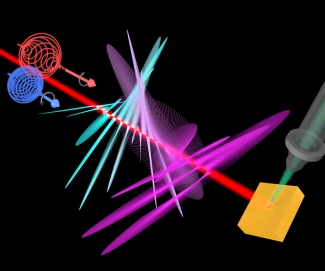Cong Chen and his colleagues in the Kapteyn/Murnane group have generated one of the most complex coherent light fields ever produced using attosecond (10-18 s) pulses of circularly polarized extreme ultraviolet (EUV) light. (The circularly polarized EUV light is shown as rotating blue sphere on the left of the picture. The complex coherent light field is illustrated with the teal, lilac, and purple structures along the driving laser beam (wide red line).
The amazing thing about this work is that the researchers accomplished it without lenses, mirrors, or other devices used to measure visible light. Because optical devices don’t work with EUV light, the team had come up with a unique way to reconstruct the new, complex light field: investigating the properties of photoelectrons generated from a copper surface by the extremely complex light field. Thus, in this seminal work, the team pioneered the generation of extremely complex light fields and developed a novel way to accurately measure those fields.
The researchers were first able to make circularly polarized EUV bursts using high-harmonic generation (HHG). Next, they came up with a clever way of transferring the information about the circularly rotating EUV light onto photoelectrons, which can be measured. For this, they irradiated a copper surface (yellow) with the circularly polarized EUV bursts, a process that kicked out photoelectrons (green) from the surface. If the surface is also illuminated with an infrared laser pulse (red, left) at the same time, the laser field can “wiggle” the photoelectrons liberated by the EUV light.
“By looking at those wiggling electrons, we observed that the electrons liberated by slightly different bursts of EUV light come out at slightly different times,” Margaret Murnane said. “And if we move the EUV and laser light waves by a very small amount, by less than a wavelength of visible light, we can rotate the direction of the circular EUV field––just like rotating the arms in a clock. This allows us to collect photoelectrons as we rotate the EUV polarization, and know everything about the most complex coherent light pulse generated to date!”
The rotation of the circular EUV field allowed the researchers to determine that circularly polarized EUV light is actually a superposition of three linear pulses offset from each other by 120 degrees. This superposition forms the new state of circularly polarized light!
With this knowledge, the researchers were able to reconstruct a complete three-dimensional map of the EUV burst from the tiny shifts of the wiggling electrons. Two factor were critical to making the map of an incredibly complicated EUV light field: (1) The photoelectrons coming from the copper surface were sensitive to the polarization of the EUV light, and (2) The researchers were able to rotate the circularly polarized EUV light as it was created.
The researchers responsible for this illuminating feat include graduate students Chen, Dmitriy Zusin, and Christian Gentry, research associates Zhensheng Tao, Ronny Knut, and Patrik Grychtol, former research associate Piotr Matyba, former graduate student Tory Carr, Fellow Associate Agnieszka Jaron-Becker, Fellows Andreas Becker, Henry Kapteyn, and Margaret Murnane as well as their colleagues from the Universidad de Salamanca (Spain) and Technion (Israel).
The reconstruction of circularly polarized EUV light opens the door to gaining a deeper understanding of atoms, molecules whose mirror images cannot be superimposed on each other, and magnetic materials.––Julie Phillips




